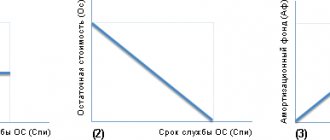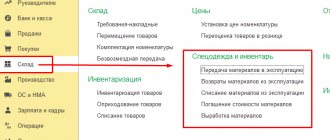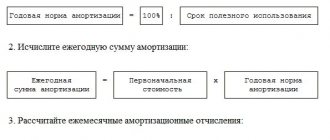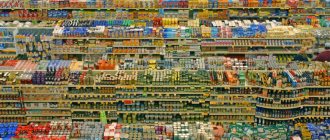Any receipt of an object of fixed assets (F), whether it be a purchase, gratuitous transfer or acquisition in exchange, entails the mandatory determination of a depreciation group, which is assigned based on the useful life of the property. It is during this period that the cost of the property gradually becomes part of the company's costs. Write-off of accrued depreciation amounts is carried out in one of four ways that are relevant for accounting established in the accounting policy of a particular enterprise.
Shock absorption groups
When registering, PF objects are assigned to a specific depreciation group. There are 10 of them in total; they are listed in the OS Classification by depreciation groups. The main criterion for combining units of property into any of the depreciation categories is the useful life (USI) of the object. It is determined by enterprises for each PF facility, based on the expected useful period, operating conditions and regulations governing the use of the property.
SPI is the main criterion for classifying an asset into one of the presented depreciation groups.
| Group | SPI property |
| 1 | From 1 year to 2 years |
| 2 | From 2 to 3 years |
| 3 | From 3 to 5 years |
| 4 | From 5 to 7 years |
| 5 | From 7 to 10 years |
| 6 | From 10 to 15 years |
| 7 | From 15 to 20 years |
| 8 | From 20 to 25 years |
| 9 | From 25 to 30 years |
| 10 | Over 30 years |
According to the general rules, the organization depreciates the received asset over the period of fixed income, determined by the Classifier (see table). If the company cannot find an object on the list, then the deadline is set based on the specifications of the asset or the manufacturer’s recommendations. If the asset is manufactured in a company, then the company’s specialists independently develop recommendations confirming the effective life of the asset. They are drawn up in any form. This may be an order from the manager or another document defining the PPI of the asset. Let's consider the characteristic features of property classified in each depreciation group.
What documents can justify the choice of depreciation group?
To avoid disputes with the tax service, you should document your choice of depreciation group for a fixed asset item.
Along with the Classification of fixed assets, entrepreneurs must prepare a list of other documents. If you study the judicial practice on this issue and identify cases where judges recognized additional taxes assessed by the tax service as illegal, you can compile a list of such documents, including:
- conclusion of an independent expert on the establishment of a depreciation group;
- Federal Highway Traffic Safety Act;
- screenshots from the website of the manufacturer of the fixed asset;
- Decree of the Government of the Russian Federation on state registration of equipment;
- vehicle registration certificate;
- Technical Regulation No. 720;
- passport of the fixed asset;
- technical documentation of the OS object.
Analysis of a specific situation
Let's study case No. A67-4196/2017. The tax service filed a statement of claim demanding recognition of the fact that the company had incorrectly chosen the depreciation group (the objects were included in depreciation groups I and II). According to representatives of the Federal Tax Service, the disputed objects belong to the group of special vehicles (IV depreciation group), and not to equipment and units, as the owner of the organization claims. The list of disputed objects includes:
- installations for repair and development of wells A-60/80 (Kungur-80) on the KrAZ 63221 chassis;
- US-6-20 NU mixing installations on the Ural 4320 chassis;
- pumping units with tank UNB 125/32U on Ural chassis;
- lifting units A 60/80 on KrAZ 63221 chassis;
- UPA 60/80 lifting units on KrAZ 63221 chassis, etc.
The organization assigned OKOF codes to units and installations:
- 14 2928060 “Equipment for development and repair of oil and gas wells”;
- 14 2928554 “Equipment for preparatory work during repair and maintenance of production wells, intensification of production and cementing of wells...”.
The organization tried to prove the unfoundedness of the claims from the tax authorities, pointing out the following points:
- the manufacturer, Rostekhnadzor and Rosstandart qualify the listed technical products as equipment;
- units and installations are not vehicles (they are not equipped with a body for cargo or passenger seats); the functional purpose of these fixed assets is not transportation of equipment from well to well, but carrying out repair, drilling and related work and operations.
Three courts at once took the side of the tax authorities, and the judge of the Supreme Court of the Russian Federation did not send the case for review (Determination No. 304-KG18-11694 dated August 10, 2021). The tax inspectorate was able to prove that the company made the wrong choice of depreciation group, thanks to witness testimony and documents mentioned earlier in the article.
The court's position was as follows. The judges pointed out that fixed assets are grouped into depreciation groups according to the main criterion - useful life (the period during which the objects are operated by the owner to achieve the goal of his activity). The documents that were submitted to the case file prove that the service life of the OS objects in question is at least 8-9 years.
The circumstances listed below indicate that fixed assets are special vehicles and belong to depreciation group IV (SPI = 7-10 years inclusive):
- All fixed assets are equipped with KrAZ, Ural chassis, include internal combustion engines, crew part, generator, chassis, braking equipment, electrical equipment and other equipment.
- Equipment located on these fixed assets (chassis) cannot operate separately from them, because the drive to the upper equipment comes from the main power unit (ICE).
- In order to drive a vehicle, the driver must first obtain a category C driving license.
- OS objects can move independently on public roads and off-road.
- They are registered with the traffic police, and transport tax is paid for them.
OKOF: code 320.26.30.11.190
Search for an entry in OKOF by code and name (at least 3 characters):
For example: 100.00.10.11 or Panel houses
- OKOF - All-Russian Classifier of Fixed Assets
- 300.00.00.00.000 - Machinery and equipment, including household equipment, and other objects
- 320.00.00.00.000 - Information, computer and telecommunications (ICT) equipment
- 320.26.30 — Communication equipment
- 320.26.30.1 - Communication equipment, radio or television transmitting equipment
- 320.26.30.11 — Communication transmitting equipment with receiving devices
- 320.26.30.11.190 - Other communication transmitting equipment with receiving devices, not included in other groups
320.26.30.11.190 - Other communication transmitting equipment with receiving devices, not included in other groups
Classifier: OKOF OK 013-2014 Code: 320.26.30.11.190 Name: Other communication equipment transmitting with receiving devices, not included in other groups Subsidiary elements: 0 Depreciation groups: 5 Direct transition keys: 55
Subgroups
Grouping 320.26.30.11.190 in OKOF is final and does not contain subgroups.
Shock absorption groups
In the classification of fixed assets included in depreciation groups, code 320.26.30.11.190 is listed in the following groups:
| Group | Subgroup | Deadlines | Note |
| First group | cars and equipment | all short-lived property with a useful life from 1 year to 2 years inclusive | special tool kits for telecommunications equipment and line-cable works; devices and equipment for operational work in connection with |
| Third group | cars and equipment | property with a useful life of over 3 years up to 5 years inclusive | telephone apparatus and special devices, payphone apparatus and radiotelephones; subscriber unit of compaction equipment; equipment for multiplexing subscriber lines; Smart Service Control Node (SCP); service edge router (BRAS/BNG/B SR); optoelectronic interface converter; batteries at communication facilities; uninterruptible power supplies |
| Fourth group | cars and equipment | property with a useful life of over 5 years up to 7 years inclusive | modems/multiplexers; DSLAM multiplexer, media converters; transponders; session border controllers (SBCs); firewalls; amplifiers; station and linear units of compaction equipment; regenerators; electronic subscriber terminals; telephone fax machines; digital mini-PBXs (rural, institutional, remote); WiFi hotspots |
| Sixth group | cars and equipment | property with a useful life of over 10 years up to 15 years inclusive | automatic and semi-automatic telephone stations; automatic and semi-automatic intercity and international telephone stations |
| Seventh group | cars and equipment | property with a useful life of over 15 years up to 20 years inclusive | switching, static and other relay and electromechanical equipment; equipment for manual maintenance of central bank and MB systems; power distribution equipment, cabinets and DC power panels for communication facilities; input-cable and input-switching equipment; rectifying and converting equipment for communications |
Transition keys
To move from the old OKOF to the new OKOF, use a direct transition key:
| OKOF OK 013-94 | OKOF OK 013-2014 | ||
| Code | Name | Code | Name |
| 14 3221138 | Television instrumentation (testing) equipment | 320.26.30.11.190 | … |
| 143222000 | Cable communication equipment and terminal and intermediate wire communication equipment | ||
| 14 3222105 | Manual telephone switches | ||
| 143222106 | Intermediate and additional equipment for telephone exchanges | ||
| 143222112 | Loudspeaking equipment | ||
| 143222214 | Subscriber and feeder transformers for wired broadcasting networks | ||
| 143222215 | Equipment and devices amplifying and transmitting for wire broadcasting | ||
| 143222216 | Broadcasting equipment | ||
| 143222311 | Control systems for automated lines and complexes | ||
| 143222312 | Machines and devices with control computer systems | ||
| 143222320 | Means of mechanization of work on communication lines | ||
| 143222321 | Installations and equipment for servicing cable lines | ||
| 143222322 | Machines for earthworks in connection | ||
| 143222323 | Mechanisms for working on communication lines | ||
| 143222325 | Instruments for determining cable leaks | ||
| 143222390 | Equipment for transmission systems with time division of channels and fiber-optic communication systems (equipment for multiplexing with pulse-code modulation) | ||
| 143222391 | Compaction equipment with pulse-code modulation 12-channel | ||
| 143222392 | Compaction equipment with pulse-code modulation 24-channel | ||
| 143222393 | Compaction equipment with pulse-code modulation 32-channel | ||
| 143222394 | Compaction equipment with pulse-code modulation 120-channel | ||
| 143222395 | Compaction equipment with pulse-code modulation 240-channel | ||
| 143222396 | Compaction equipment with pulse-code modulation 360-channel | ||
| 143222397 | Compaction equipment with pulse-code modulation 1920-channel | ||
| 143313430 | Multifunctional telemechanics device complexes | ||
| 143313431 | Complexes of multifunctional telemechanics devices operating via physical channels to serve one transmission channel | ||
| 143313432 | Complexes of multifunctional telemechanics devices operating through physical channels of a radial structure to serve several transmission channels | ||
| 143313433 | Complexes of multifunctional telemechanics devices operating through physical channels of a chain structure | ||
| 143313434 | Complexes of multifunctional telemechanics devices operating through physical channels of a tree structure | ||
| 143313435 | Complexes of telemechanics devices are multifunctional, operating on any channels to serve one transmission channel | ||
| 143313436 | Complexes of multifunctional telemechanics devices operating on any channels of a radial structure to serve several transmission channels | ||
| 143313437 | Multifunctional telemechanics device complexes operating through any channels of a chain structure | ||
| 143313438 | Multifunctional telemechanics device complexes, operating through any channels of a tree structure | ||
| 143313439 | Complexes of multifunctional telemechanics devices operating on any channels of any structure to serve several transmission channels | ||
| 143313440 | Alphanumeric information transmission devices (data transmission equipment) | ||
| 143313441 | Data transmission equipment for intra-industrial networks operating in simplex mode | ||
| 143313442 | Data transmission equipment for intra-industrial networks operating in half-duplex mode | ||
| 143313443 | Data transmission equipment for intra-industrial networks operating in full duplex mode | ||
| 143313444 | Data transmission equipment for urban networks operating in simplex mode | ||
| 143313445 | Data transmission equipment for metropolitan networks operating in half-duplex mode | ||
| 143313446 | Data transmission equipment for urban networks operating in duplex mode | ||
| 143313447 | Data transmission equipment for long-distance networks operating in half-duplex mode | ||
| 143313448 | Data transmission equipment for long-distance networks operating in full duplex mode | ||
| 143313449 | Data concentration devices | ||
| 143313450 | Signal conversion devices (modems) | ||
| 143313451 | Signal conversion devices for city and long-distance networks with two- and four-wire terminations with synchronous transmission | ||
| 143313452 | Signal conversion devices for city and long-distance networks with two- and four-wire terminations with asynchronous transmission | ||
| 143313453 | Signal conversion devices for city and long-distance networks with four-wire terminations with synchronous transmission over non-switched communication channels | ||
| 143313454 | Signal conversion devices for city and long-distance networks with two- and four-wire terminations with synchronous transmission over non-switched communication channels | ||
| 143313455 | Signal conversion devices for city and long-distance networks operating in half-duplex mode with parallel transmission | ||
| 143313460 | Telemechanical control panels and consoles | ||
| 143313461 | Panel control boards | ||
| 143313462 | Mosaic control boards | ||
| 143313465 | Dispatch consoles | ||
| 143313470 | Panels and consoles for automated production process control systems | ||
| 143313493 | Service equipment for telemechanics equipment | ||
Concept and composition of fixed assets
What is OS?
The fixed assets of an enterprise include assets that have a material expression and strictly meet the criteria established by law, which we will discuss in more detail in the next section of the article. Such assets include buildings, structures, machinery, equipment, instruments intended for measurements and adjustments, computers, transport, tools, equipment, road infrastructure, as well as other types of assets.
In agricultural organizations, fixed assets include breeding and draft animals and perennial plants.
OS can also include land plots, capital investments for their improvement (for example, reclamation or irrigation work), as well as natural resources such as water, subsoil, etc. That is, OS are the fixed assets of an enterprise.
Important! Objects of tangible assets do not belong to fixed assets if they are located in the warehouses of trading or manufacturing enterprises that manufacture them. In this case, they are accounted for as goods held for sale or as finished goods.
For accounting purposes, the accounting policies (hereinafter referred to as AP) of organizations may provide for a cost limit, below which assets that meet the criteria for recognition as fixed assets in accounting can be classified as inventories. In this case, the specified limit should not exceed 40,000 rubles. (paragraph 4, clause 5 of the Regulations on OS accounting (PBU 6/01)).
Important! Fixed assets, the use of which is limited to leasing, are recognized in accounting and reporting as profitable investments in material assets.
As a general rule, capital investments do not belong to the fixed assets of an enterprise (clause 3 of PBU 6/01). Capital investments in leased fixed assets can be included in their composition (paragraph 2, paragraph 5 of PBU 6/01).



